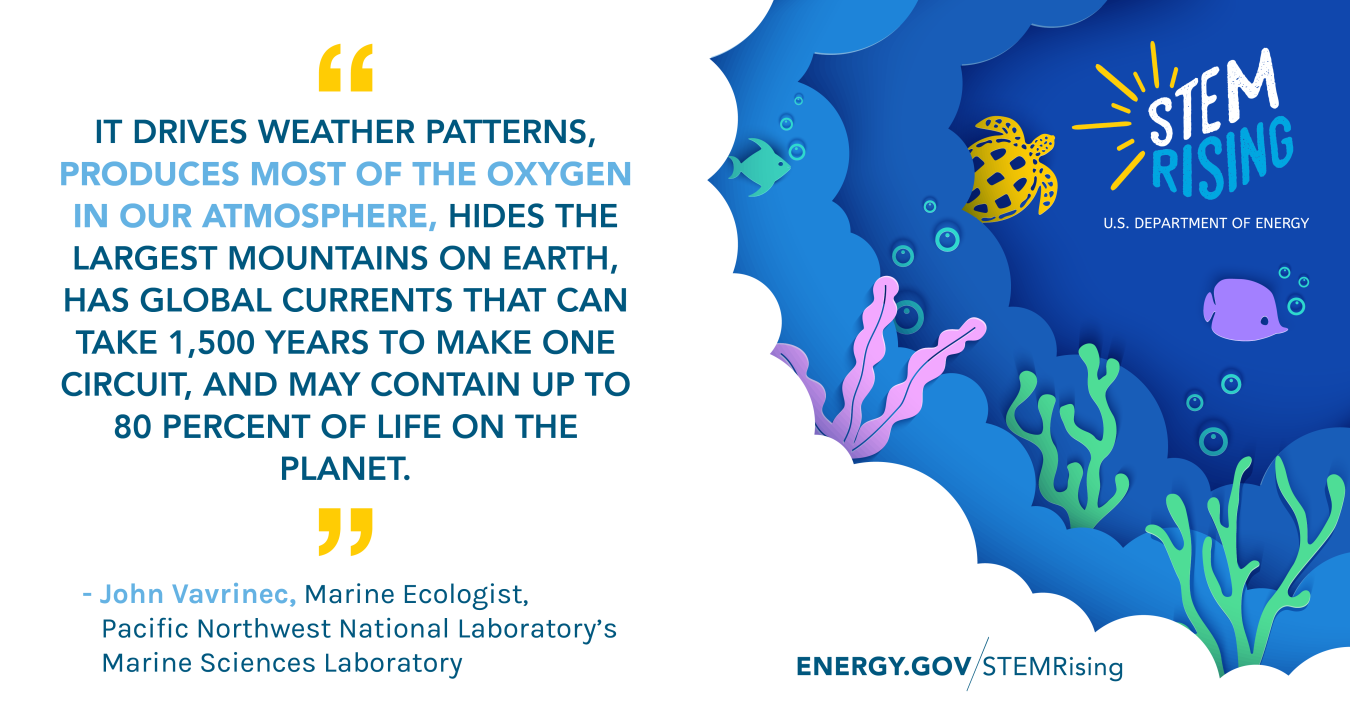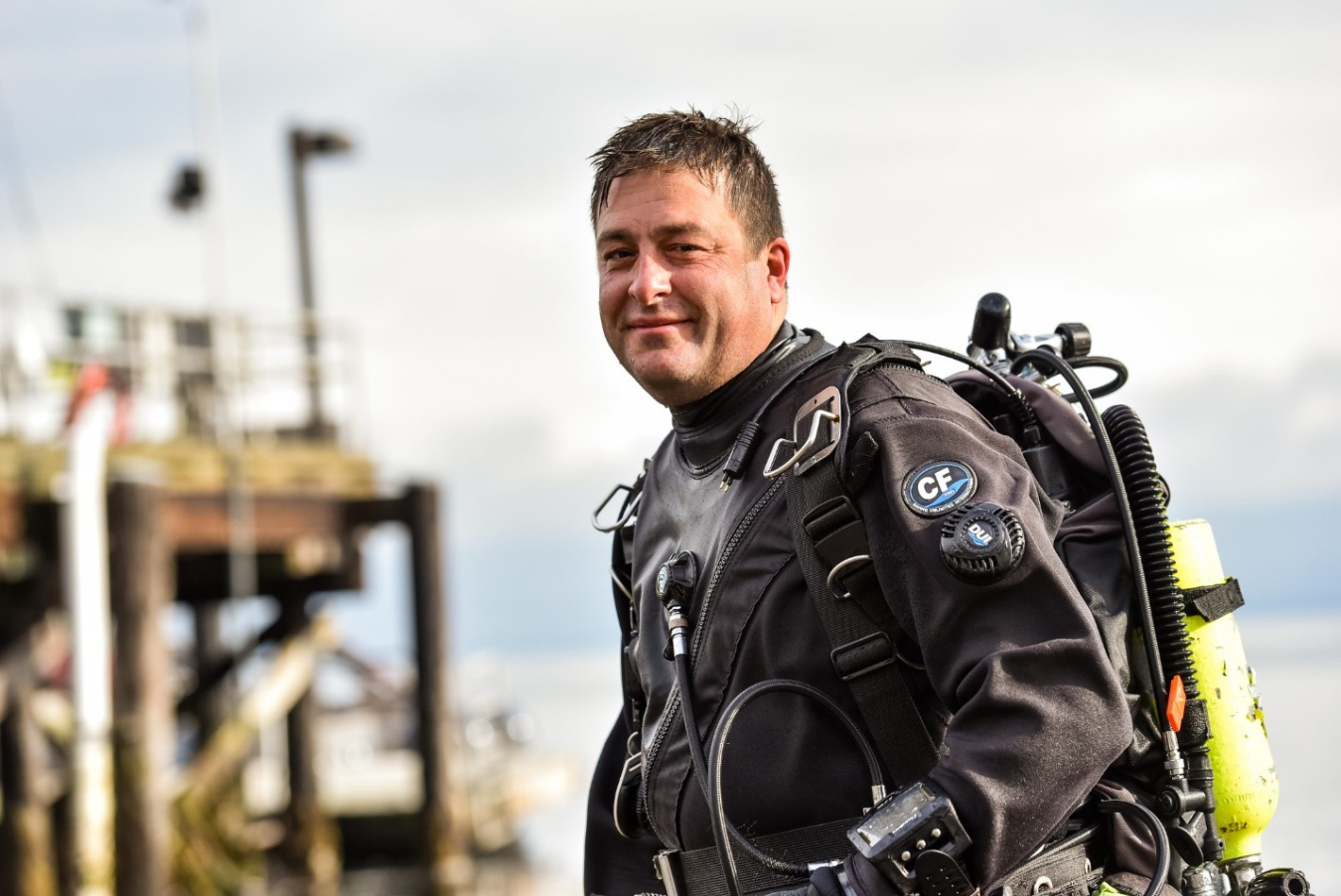Learn why John Vavrinec loves his job as a marine ecologist at the Pacific Northwest National Laboratory Marine Sciences Laboratory.
June 30, 2020
June is Ocean Month, and to celebrate STEM Rising is sharing profiles of Energy Department staff in ocean-related careers. Meet John Vavrinec.
My name is John Vavrinec and I am a marine ecologist at the Pacific Northwest National Laboratory (PNNL)’s Marine Sciences Laboratory in Sequim. I am also the PNNL dive officer in charge of the scientific dive team, a PNNL STEM ambassador, and adjunct faculty at Western Washington University’s Huxley in the Peninsulas Program. I came to PNNL 15 years ago after getting my PhD in Oceanography at the University of Maine and working at National Oceanic and Atmospheric Administration Fisheries in Seattle. I have spent my whole PNNL career at the Sequim campus, but my work here has brought me to many places including all around Puget Sound and the Columbia River, Florida, New England, Hawaii, and even Kuwait.

What’s your favorite fact about the ocean?
One of the things I love about the ocean is that it covers over 70 percent of the Earth, and it has an incredible diversity of habitats, populations, and processes. It drives weather patterns, produces most of the oxygen in our atmosphere, hides the largest mountains on Earth, has global currents that can take 1,500 years to make one circuit, and may contain up to 80 percent of life on the planet. You can’t get bored with the ocean if you look around because it can always show you something new. They say that we know more about the moon than we do about the oceans, and while I am not sure that is completely true, the oceans have much to be discovered.
What do you do to celebrate Ocean Month?
The nice thing about being a marine ecologist/oceanographer is that every month is Ocean Month for me. This month I have already planted over 12,000 eelgrass plants to restore an area on Harstine Island. I am teaching a college oceanography course and am doing a number of STEM outreach events. Introducing people to ocean is always a lot of fun, as is sharing anything you really care about.
What inspired you to work in water power?
The potential for energy in the ocean is immense, but like all technologies we need to apply equipment to harness this energy with forethought and make decisions based on science so we are not doing more harm than good. Our team of ecologists and other marine scientists want to apply basic science to solutions like water power technologies, so we protect the environment while helping to solve issues facing the world.
What do you do in your job?
I am lucky to have a job that has incredibly varied over time. As a marine ecologist, I study the interactions of the organisms with their environment and when possible apply that knowledge to solve real work problems. For example, we are currently doing a lot of work to restore eelgrass populations, a critical habitat providing many ecosystem services, in places around Puget Sound. As the dive officer and boat operator at PNNL, I also get to help others with their field work, whether it is surveys on the bottom, deployment of sensors, understanding currents, or sampling the water chemistry. I specialize in field research, so I get to spend a lot of time on or in the water in all types of weather, seasons, and locations.
What books or movies about the ocean do you recommend?
Because the ocean and its residents are so fascinating, there are many books that take a hard look at individual species, communities, or oceanographic phenomenon—people can almost always find something they are interested in. One of the first books I read specifically about a marine species was Beautiful Swimmers by William Warner. It is about the blue crab, Callinectes sapidus, which I was studying at the time in the Chesapeake Bay. The book not only goes into the biology of the blue crabs and their importance to the local ecology, but also into the economic importance and the waterman culture that fishes for them. It is written in an engaging way that completely sucks you into the story. Next on my list is The Soul of the Octopus by Si Montgomery which a friend lent me and my son just finished. But as I said, you can find anything that interests you, from general overviews (like Rachel Carson’s The Sea Around Us) to stories of the science (like John Steinbeck’s The Log from the Sea of Cortez) and stories of survival (like In the Heart of the Sea by Nathaniel Philbrick), to even fantasy (Jules Verne Twenty Thousand Leagues Under the Sea, anyone?). And I can’t even tell you how many ocean themed children’s books we have in our house. My children used to love hearing me pronounce all the Hawaiian names in Let's Call Him Lau-Wiliwili-Humuhumu-Nukunuku-Nukunuku-Apua'A-Oi'Oi (Tim Myers)!
I have two general thoughts. First, educate yourself broadly. I may primarily be a biologist, but I got my PhD in oceanography to better understand all the factors, biotic and abiotic, that goes into forming ecosystems. This includes biology, chemistry, and geology, as well as physics and mathematics to understand the movements of the ocean—you can touch on it all. Secondly, take advantages of opportunities that you come across. They might be volunteer opportunities, internships, jobs, anything to get experience in the field. Not only will you experience things first hand and build up your resume, but you will start to learn what you like and, as just importantly, don’t like in the marine sciences so you can focus on the things that really fascinate you. The field is large and diverse and anything to help focus your ultimate goals is never a wasted effort.
For more Ocean Month profiles and STEM resources, visit STEM Rising.

